From Wikipedia, the free encyclopedia
https://en.wikipedia.org/wiki/Kinematics
Kinematics is a subfield of physics, developed in classical mechanics, that describes the motion of points, bodies (objects), and systems of bodies (groups of objects) without considering the forces that cause them to move. Kinematics, as a field of study, is often referred to as the "geometry of motion" and is occasionally seen as a branch of mathematics. A kinematics problem begins by describing the geometry of the system and declaring the initial conditions
of any known values of position, velocity and/or acceleration of points
within the system. Then, using arguments from geometry, the position,
velocity and acceleration of any unknown parts of the system can be
determined. The study of how forces act on bodies falls within kinetics, not kinematics. For further details, see analytical dynamics.
Kinematics is used in astrophysics to describe the motion of celestial bodies and collections of such bodies. In mechanical engineering, robotics, and biomechanics kinematics is used to describe the motion of systems composed of joined parts (multi-link systems) such as an engine, a robotic arm or the human skeleton.
Geometric transformations, also called rigid transformations, are used to describe the movement of components in a mechanical system, simplifying the derivation of the equations of motion. They are also central to dynamic analysis.
Kinematic analysis is the process of measuring the kinematic quantities
used to describe motion. In engineering, for instance, kinematic
analysis may be used to find the range of movement for a given mechanism and working in reverse, using kinematic synthesis to design a mechanism for a desired range of motion. In addition, kinematics applies algebraic geometry to the study of the mechanical advantage of a mechanical system or mechanism.
Etymology of the term
The term kinematic is the English version of A.M. Ampère's cinématique, which he constructed from the Greek κίνημα kinema ("movement, motion"), itself derived from κινεῖν kinein ("to move").
Kinematic and cinématique are related to the French word cinéma,
but neither are directly derived from it. However, they do share a root
word in common, as cinéma came from the shortened form of
cinématographe, "motion picture projector and camera", once again from
the Greek word for movement and from the Greek γρᾰ́φω grapho ("to write").
Kinematics of a particle trajectory in a non-rotating frame of reference
Kinematic quantities of a classical particle: mass m, position r, velocity v, acceleration a.
Position vector r, always points radially from the origin.
Velocity vector v, always tangent to the path of motion.
Acceleration vector a,
not parallel to the radial motion but offset by the angular and
Coriolis accelerations, nor tangent to the path but offset by the
centripetal and radial accelerations.
Kinematic
vectors in plane polar coordinates. Notice the setup is not restricted
to 2-d space, but a plane in any higher dimension.
Particle kinematics is the study of the trajectory of particles. The
position of a particle is defined as the coordinate vector from the
origin of a coordinate frame to the particle. For example, consider a
tower 50 m south from your home, where the coordinate frame is centered
at your home, such that east is in the direction of the x-axis and north is in the direction of the y-axis, then the coordinate vector to the base of the tower is r = (0 m, −50 m, 0 m). If the tower is 50 m high, and this height is measured along the z-axis, then the coordinate vector to the top of the tower is r = (0 m, −50 m, 50 m).
In the most general case, a three-dimensional coordinate system
is used to define the position of a particle. However, if the particle
is constrained to move within a plane, a two-dimensional coordinate
system is sufficient. All observations in physics are incomplete without
being described with respect to a reference frame.
The position vector of a particle is a vector
drawn from the origin of the reference frame to the particle. It
expresses both the distance of the point from the origin and its
direction from the origin. In three dimensions, the position vector  can be expressed as
can be expressed as

where

,

, and

are the
Cartesian coordinates and

,

and

are the unit vectors along the

,

, and

coordinate axes, respectively. The magnitude of the position vector

gives the distance between the point

and the origin.

The
direction cosines
of the position vector provide a quantitative measure of direction. In
general, an object's position vector will depend on the frame of
reference; different frames will lead to different values for the
position vector.
The trajectory of a particle is a vector function of time,  , which defines the curve traced by the moving particle, given by
, which defines the curve traced by the moving particle, given by

where

,

, and

describe each coordinate of the particle's position as a function of time.
The distance travelled is always greater than or equal to the displacement.
Velocity and speed
The velocity
of a particle is a vector quantity that describes the magnitude as well
as direction of motion of the particle. More mathematically, the rate
of change of the position vector of a point, with respect to time is the
velocity of the point. Consider the ratio formed by dividing the
difference of two positions of a particle by the time interval. This
ratio is called the average velocity over that time interval and is
defined as

where

is the change in the position vector during the time interval

. In the limit that the time interval

approaches zero, the average velocity approaches the instantaneous
velocity, defined as the time derivative of the position vector,

where the dot denotes a derivative with respect to time (e.g.

). Thus, a particle's velocity is the time rate of change of its position. Furthermore, this velocity is
tangent
to the particle's trajectory at every position along its path. Note
that in a non-rotating frame of reference, the derivatives of the
coordinate directions are not considered as their directions and
magnitudes are constants.
The speed of an object is the magnitude of its velocity. It is a scalar quantity:

where

is the arc-length measured along the trajectory of the particle. This
arc-length must always increase as the particle moves. Hence,

is non-negative, which implies that speed is also non-negative.
Acceleration
The
velocity vector can change in magnitude and in direction or both at
once. Hence, the acceleration accounts for both the rate of change of
the magnitude of the velocity vector and the rate of change of direction
of that vector. The same reasoning used with respect to the position of
a particle to define velocity, can be applied to the velocity to define
acceleration. The acceleration
of a particle is the vector defined by the rate of change of the
velocity vector. The average acceleration of a particle over a time
interval is defined as the ratio.

where Δ
v is the difference in the velocity vector and Δ
t is the time interval.
The acceleration of the particle is the limit of the average
acceleration as the time interval approaches zero, which is the time
derivative,

or

Thus, acceleration is the first derivative of the velocity vector and
the second derivative of the position vector of that particle. Note that
in a non-rotating frame of reference, the derivatives of the coordinate
directions are not considered as their directions and magnitudes are
constants.
The magnitude of the acceleration of an object is the magnitude |a| of its acceleration vector. It is a scalar quantity:

Relative position vector
A relative position vector is a vector that defines the position of one point relative to another. It is the difference in position of the two points.
The position of one point A relative to another point B is simply the difference between their positions

which is the difference between the components of their position vectors.
If point A has position components 
If point B has position components 
then the position of point A relative to point B is the difference between their components: 
Relative velocity
Relative velocities between two particles in classical mechanics.
The velocity of one point relative to another is simply the difference between their velocities

which is the difference between the components of their velocities.
If point A has velocity components  and point B has velocity components
and point B has velocity components  then the velocity of point A relative to point B is the difference between their components:
then the velocity of point A relative to point B is the difference between their components:

Alternatively, this same result could be obtained by computing the time derivative of the relative position vector rB/A.
In the case where the velocity is close to the speed of light c (generally within 95%), another scheme of relative velocity called rapidity, which depends on the ratio of v to c, is used in special relativity.
Relative acceleration
The acceleration of one point C relative to another point B is simply the difference between their accelerations.

which is the difference between the components of their accelerations.
If point C has acceleration components  and point B has acceleration components
and point B has acceleration components  then the acceleration of point C relative to point B is the difference between their components:
then the acceleration of point C relative to point B is the difference between their components: 
Alternatively, this same result could be obtained by computing the second time derivative of the relative position vector rB/A.
Assuming that the initial conditions of the position,  , and velocity
, and velocity  at time
at time  are known, the first integration yields the velocity of the particle as a function of time.
are known, the first integration yields the velocity of the particle as a function of time.

A second integration yields its path (trajectory),

Additional relations between displacement, velocity, acceleration, and time can be derived. Since the acceleration is constant,

can be substituted into the above equation to give:

A relationship between velocity, position and acceleration
without explicit time dependence can be had by solving the average
acceleration for time and substituting and simplifying


where

denotes the
dot product, which is appropriate as the products are scalars rather than vectors.

The dot product can be replaced by the cosine of the angle α between the vectors (see Geometric interpretation of the dot product for more details) and the vectors by their magnitudes, in which case:

In the case of acceleration always in the direction of the
motion and the direction of motion should be in positive or negative,
the angle between the vectors (α) is 0, so  , and
, and

This can be simplified using the notation for the magnitudes of the vectors

where

can be any curvaceous path taken as the constant tangential acceleration is applied along that path, so

This reduces the parametric equations of motion of the particle to a
Cartesian relationship of speed versus position. This relation is useful
when time is unknown. We also know that  or
or  is the area under a velocity–time graph.
is the area under a velocity–time graph.
Velocity Time physics graph
We can take  by adding the top area and the bottom area. The bottom area is a rectangle, and the area of a rectangle is the
by adding the top area and the bottom area. The bottom area is a rectangle, and the area of a rectangle is the  where
where  is the width and
is the width and  is the height. In this case
is the height. In this case  and
and  (note that the
(note that the  here is different from the acceleration
here is different from the acceleration  ). This means that the bottom area is
). This means that the bottom area is  . Now let's find the top area (a triangle). The area of a triangle is
. Now let's find the top area (a triangle). The area of a triangle is  where
where  is the base and
is the base and  is the height. In this case,
is the height. In this case,  and
and  or
or  . Adding
. Adding  and
and  results in the equation
results in the equation  results in the equation
results in the equation  . This equation is applicable when the final velocity v is unknown.
. This equation is applicable when the final velocity v is unknown.
Figure
2: Velocity and acceleration for nonuniform circular motion: the
velocity vector is tangential to the orbit, but the acceleration vector
is not radially inward because of its tangential component aθ that increases the rate of rotation: dω/dt = |aθ|/R.
Particle trajectories in cylindrical-polar coordinates
It is often convenient to formulate the trajectory of a particle r(t) = (x(t), y(t), z(t)) using polar coordinates in the X–Y plane. In this case, its velocity and acceleration take a convenient form.
Recall that the trajectory of a particle P is defined by its coordinate vector r measured in a fixed reference frame F. As the particle moves, its coordinate vector r(t) traces its trajectory, which is a curve in space, given by:

where
i,
j, and
k are the unit vectors along the
X,
Y and
Z axes of the
reference frame F, respectively.
Consider a particle P that moves only on the surface of a circular cylinder r(t) = constant, it is possible to align the Z axis of the fixed frame F with the axis of the cylinder. Then, the angle θ around this axis in the X–Y plane can be used to define the trajectory as,

where the constant distance from the center is denoted as
R, and
θ =
θ(
t) is a function of time.
The cylindrical coordinates for r(t) can be simplified by introducing the radial and tangential unit vectors,

and their time derivatives from elementary calculus:




Using this notation, r(t) takes the form,

In general, the trajectory
r(
t) is not constrained to lie on a circular cylinder, so the radius
R varies with time and the trajectory of the particle in cylindrical-polar coordinates becomes:

Where
R,
θ, and
z might be continuously
differentiable functions of time and the function notation is dropped
for simplicity. The velocity vector
vP is the time derivative of the trajectory
r(
t), which yields:

Similarly, the acceleration aP, which is the time derivative of the velocity vP, is given by:

The term  acts toward the center of curvature of the path at that point on the
path, is commonly called the centripetal acceleration. The term
acts toward the center of curvature of the path at that point on the
path, is commonly called the centripetal acceleration. The term  is called the Coriolis acceleration.
is called the Coriolis acceleration.
Constant radius
If the trajectory of the particle is constrained to lie on a cylinder, then the radius R is constant and the velocity and acceleration vectors simplify. The velocity of vP is the time derivative of the trajectory r(t),

Planar circular trajectories
Each particle on the wheel travels in a planar circular trajectory (Kinematics of Machinery, 1876).
A special case of a particle trajectory on a circular cylinder occurs when there is no movement along the Z axis:

where
R and
z0 are constants. In this case, the velocity
vP is given by:

where

is the
angular velocity of the unit vector
eθ around the
z axis of the cylinder.
The acceleration aP of the particle P is now given by:

The components

are called, respectively, the
radial and
tangential components of acceleration.
The notation for angular velocity and angular acceleration is often defined as

so the radial and tangential acceleration components for circular trajectories are also written as

Point trajectories in a body moving in the plane
The movement of components of a mechanical system are analyzed by attaching a reference frame
to each part and determining how the various reference frames move
relative to each other. If the structural stiffness of the parts are
sufficient, then their deformation can be neglected and rigid
transformations can be used to define this relative movement. This
reduces the description of the motion of the various parts of a
complicated mechanical system to a problem of describing the geometry of
each part and geometric association of each part relative to other
parts.
Geometry
is the study of the properties of figures that remain the same while
the space is transformed in various ways—more technically, it is the
study of invariants under a set of transformations.[20]
These transformations can cause the displacement of the triangle in the
plane, while leaving the vertex angle and the distances between
vertices unchanged. Kinematics is often described as applied geometry,
where the movement of a mechanical system is described using the rigid
transformations of Euclidean geometry.
The coordinates of points in a plane are two-dimensional vectors in R2 (two dimensional space). Rigid transformations are those that preserve the distance between any two points. The set of rigid transformations in an n-dimensional space is called the special Euclidean group on Rn, and denoted SE(n).
Displacements and motion
The
movement of each of the components of the Boulton & Watt Steam
Engine (1784) is modeled by a continuous set of rigid displacements.
The position of one component of a mechanical system relative to another is defined by introducing a reference frame, say M, on one that moves relative to a fixed frame, F, on the other. The rigid transformation, or displacement, of M relative to F defines the relative position of the two components. A displacement consists of the combination of a rotation and a translation.
The set of all displacements of M relative to F is called the configuration space of M. A smooth curve from one position to another in this configuration space is a continuous set of displacements, called the motion of M relative to F. The motion of a body consists of a continuous set of rotations and translations.
Matrix representation
The combination of a rotation and translation in the plane R2
can be represented by a certain type of 3×3 matrix known as a
homogeneous transform. The 3×3 homogeneous transform is constructed from
a 2×2 rotation matrix A(φ) and the 2×1 translation vector d = (dx, dy), as:
![{\displaystyle [T(\phi ,\mathbf {d} )]={\begin{bmatrix}A(\phi )&\mathbf {d} \\\mathbf {0} &1\end{bmatrix}}={\begin{bmatrix}\cos \phi &-\sin \phi &d_{x}\\\sin \phi &\cos \phi &d_{y}\\0&0&1\end{bmatrix}}.}](https://wikimedia.org/api/rest_v1/media/math/render/svg/50078656eb1b2395a2ad84383cd16868c54649b1)
These homogeneous transforms perform rigid transformations on the points in the plane
z = 1, that is, on points with coordinates
r = (
x,
y, 1).
In particular, let r define the coordinates of points in a reference frame M coincident with a fixed frame F. Then, when the origin of M is displaced by the translation vector d relative to the origin of F and rotated by the angle φ relative to the x-axis of F, the new coordinates in F of points in M are given by:
![{\displaystyle \mathbf {P} =[T(\phi ,\mathbf {d} )]\mathbf {r} ={\begin{bmatrix}\cos \phi &-\sin \phi &d_{x}\\\sin \phi &\cos \phi &d_{y}\\0&0&1\end{bmatrix}}{\begin{bmatrix}x\\y\\1\end{bmatrix}}.}](https://wikimedia.org/api/rest_v1/media/math/render/svg/9654bfae7e5d0f825ec57848bd5ab493f408804f)
Homogeneous transforms represent affine transformations. This formulation is necessary because a translation is not a linear transformation of R2. However, using projective geometry, so that R2 is considered a subset of R3, translations become affine linear transformations.
Pure translation
If a rigid body moves so that its reference frame M does not rotate (θ = 0) relative to the fixed frame F, the motion is called pure translation. In this case, the trajectory of every point in the body is an offset of the trajectory d(t) of the origin of M, that is:
![{\displaystyle \mathbf {r} (t)=[T(0,\mathbf {d} (t))]\mathbf {p} =\mathbf {d} (t)+\mathbf {p} .}](https://wikimedia.org/api/rest_v1/media/math/render/svg/32f22d9b4fcc015f80b746db422f93b8d8d145dc)
Thus, for bodies in pure translation, the velocity and acceleration of every point P in the body are given by:

where the dot denotes the derivative with respect to time and
vO and
aO are the velocity and acceleration, respectively, of the origin of the moving frame
M. Recall the coordinate vector
p in
M is constant, so its derivative is zero.
Rotation of a body around a fixed axis
Figure 1: The angular velocity vector
Ω points up for counterclockwise rotation and down for clockwise rotation, as specified by the
right-hand rule. Angular position
θ(
t) changes with time at a rate
ω(t) = dθ/dt.
Rotational or angular kinematics is the description of the rotation of an object. In what follows, attention is restricted to simple rotation about an axis of fixed orientation. The z-axis has been chosen for convenience.
Position
This allows the description of a rotation as the angular position of a planar reference frame M relative to a fixed F about this shared z-axis. Coordinates p = (x, y) in M are related to coordinates P = (X, Y) in F by the matrix equation:
![{\displaystyle \mathbf {P} (t)=[A(t)]\mathbf {p} ,}](https://wikimedia.org/api/rest_v1/media/math/render/svg/3a4e865fc0f6be2e59e479f4b0a03f8114971382)
where
![{\displaystyle [A(t)]={\begin{bmatrix}\cos(\theta (t))&-\sin(\theta (t))\\\sin(\theta (t))&\cos(\theta (t))\end{bmatrix}},}](https://wikimedia.org/api/rest_v1/media/math/render/svg/53916525d50fa175a581d579e61b62d7d8a4610d)
is the rotation matrix that defines the angular position of
M relative to
F as a function of time.
Velocity
If the point p does not move in M, its velocity in F is given by
![{\displaystyle \mathbf {v} _{P}={\dot {\mathbf {P} }}=[{\dot {A}}(t)]\mathbf {p} .}](https://wikimedia.org/api/rest_v1/media/math/render/svg/701dae17b9e581be69746145fd6133e7f07f2f16)
It is convenient to eliminate the coordinates
p and write this as an operation on the trajectory
P(
t),
![{\displaystyle \mathbf {v} _{P}=[{\dot {A}}(t)][A(t)^{-1}]\mathbf {P} =[\Omega ]\mathbf {P} ,}](https://wikimedia.org/api/rest_v1/media/math/render/svg/8fac9117de99ee6837c171f5f46eede17890bcba)
where the matrix
![{\displaystyle [\Omega ]={\begin{bmatrix}0&-\omega \\\omega &0\end{bmatrix}},}](https://wikimedia.org/api/rest_v1/media/math/render/svg/eed637d1916abe2a271e19c744c416d1cf20e4f0)
is known as the angular velocity matrix of
M relative to
F. The parameter
ω is the time derivative of the angle
θ, that is:

Acceleration
The acceleration of P(t) in F is obtained as the time derivative of the velocity,
![{\displaystyle \mathbf {A} _{P}={\ddot {P}}(t)=[{\dot {\Omega }}]\mathbf {P} +[\Omega ]{\dot {\mathbf {P} }},}](https://wikimedia.org/api/rest_v1/media/math/render/svg/62a4ca56d89ccc6d2ec6d0daffd6907b9c47ccd5)
which becomes
![{\displaystyle \mathbf {A} _{P}=[{\dot {\Omega }}]\mathbf {P} +[\Omega ][\Omega ]\mathbf {P} ,}](https://wikimedia.org/api/rest_v1/media/math/render/svg/50d611f89cc9b7358cec772370a6ee8d79a792a9)
where
![{\displaystyle [{\dot {\Omega }}]={\begin{bmatrix}0&-\alpha \\\alpha &0\end{bmatrix}},}](https://wikimedia.org/api/rest_v1/media/math/render/svg/d6ebb7e70e2d2370e781ee86ea55cd0fb7d469d7)
is the angular acceleration matrix of
M on
F, and

The description of rotation then involves these three quantities:
- Angular position: the oriented distance from a selected origin on the rotational axis to a point of an object is a vector r(t) locating the point. The vector r(t) has some projection (or, equivalently, some component) r⊥(t) on a plane perpendicular to the axis of rotation. Then the angular position of that point is the angle θ from a reference axis (typically the positive x-axis) to the vector r⊥(t) in a known rotation sense (typically given by the right-hand rule).
- Angular velocity: the angular velocity ω is the rate at which the angular position θ changes with respect to time t:

- Angular acceleration: the magnitude of the angular acceleration α is the rate at which the angular velocity ω changes with respect to time t:

The equations of translational kinematics can easily be extended to
planar rotational kinematics for constant angular acceleration with
simple variable exchanges:




Here θi and θf are, respectively, the initial and final angular positions, ωi and ωf are, respectively, the initial and final angular velocities, and α
is the constant angular acceleration. Although position in space and
velocity in space are both true vectors (in terms of their properties
under rotation), as is angular velocity, angle itself is not a true
vector.
Point trajectories in body moving in three dimensions
Important formulas in kinematics define the velocity
and acceleration of points in a moving body as they trace trajectories
in three-dimensional space. This is particularly important for the
center of mass of a body, which is used to derive equations of motion
using either Newton's second law or Lagrange's equations.
Position
In order to define these formulas, the movement of a component B of a mechanical system is defined by the set of rotations [A(t)] and translations d(t) assembled into the homogeneous transformation [T(t)]=[A(t), d(t)]. If p is the coordinates of a point P in B measured in the moving reference frame M, then the trajectory of this point traced in F is given by:
![{\displaystyle \mathbf {P} (t)=[T(t)]\mathbf {p} ={\begin{bmatrix}\mathbf {P} \\1\end{bmatrix}}={\begin{bmatrix}A(t)&\mathbf {d} (t)\\0&1\end{bmatrix}}{\begin{bmatrix}\mathbf {p} \\1\end{bmatrix}}.}](https://wikimedia.org/api/rest_v1/media/math/render/svg/6e928b50529956cc7ca762cee6969f7321c5cf9d)
This notation does not distinguish between
P = (X, Y, Z, 1), and
P = (X, Y, Z), which is hopefully clear in context.
This equation for the trajectory of P can be inverted to compute the coordinate vector p in M as:
![{\displaystyle \mathbf {p} =[T(t)]^{-1}\mathbf {P} (t)={\begin{bmatrix}\mathbf {p} \\1\end{bmatrix}}={\begin{bmatrix}A(t)^{\text{T}}&-A(t)^{\text{T}}\mathbf {d} (t)\\0&1\end{bmatrix}}{\begin{bmatrix}\mathbf {P} (t)\\1\end{bmatrix}}.}](https://wikimedia.org/api/rest_v1/media/math/render/svg/3e1aa622ad90b69b42880d95b90afb0b27407a60)
This expression uses the fact that the transpose of a rotation matrix is also its inverse, that is:
![{\displaystyle [A(t)]^{\text{T}}[A(t)]=I.\!}](https://wikimedia.org/api/rest_v1/media/math/render/svg/e132dec7e35a3f7b5135d601bb20851ce2abe646)
Velocity
The velocity of the point P along its trajectory P(t) is obtained as the time derivative of this position vector,
![{\displaystyle \mathbf {v} _{P}=[{\dot {T}}(t)]\mathbf {p} ={\begin{bmatrix}\mathbf {v} _{P}\\0\end{bmatrix}}=\left({\frac {d}{dt}}{\begin{bmatrix}A(t)&\mathbf {d} (t)\\0&1\end{bmatrix}}\right){\begin{bmatrix}\mathbf {p} \\1\end{bmatrix}}={\begin{bmatrix}{\dot {A}}(t)&{\dot {\mathbf {d} }}(t)\\0&0\end{bmatrix}}{\begin{bmatrix}\mathbf {p} \\1\end{bmatrix}}.}](https://wikimedia.org/api/rest_v1/media/math/render/svg/4d216e15ab36a895fa2fa109fbdf77b9590d5ccb)
The dot denotes the derivative with respect to time; because
p is constant, its derivative is zero.
This formula can be modified to obtain the velocity of P by operating on its trajectory P(t) measured in the fixed frame F. Substituting the inverse transform for p into the velocity equation yields:
![{\displaystyle {\begin{aligned}\mathbf {v} _{P}&=[{\dot {T}}(t)][T(t)]^{-1}\mathbf {P} (t)\\[4pt]&={\begin{bmatrix}\mathbf {v} _{P}\\0\end{bmatrix}}={\begin{bmatrix}{\dot {A}}&{\dot {\mathbf {d} }}\\0&0\end{bmatrix}}{\begin{bmatrix}A&\mathbf {d} \\0&1\end{bmatrix}}^{-1}{\begin{bmatrix}\mathbf {P} (t)\\1\end{bmatrix}}\\[4pt]&={\begin{bmatrix}{\dot {A}}&{\dot {\mathbf {d} }}\\0&0\end{bmatrix}}A^{-1}{\begin{bmatrix}1&-\mathbf {d} \\0&A\end{bmatrix}}{\begin{bmatrix}\mathbf {P} (t)\\1\end{bmatrix}}\\[4pt]&={\begin{bmatrix}{\dot {A}}A^{-1}&-{\dot {A}}A^{-1}\mathbf {d} +{\dot {\mathbf {d} }}\\0&0\end{bmatrix}}{\begin{bmatrix}\mathbf {P} (t)\\1\end{bmatrix}}\\[4pt]&={\begin{bmatrix}{\dot {A}}A^{\text{T}}&-{\dot {A}}A^{\text{T}}\mathbf {d} +{\dot {\mathbf {d} }}\\0&0\end{bmatrix}}{\begin{bmatrix}\mathbf {P} (t)\\1\end{bmatrix}}\\[6pt]\mathbf {v} _{P}&=[S]\mathbf {P} .\end{aligned}}}](https://wikimedia.org/api/rest_v1/media/math/render/svg/6aa70149e117b2b14b1f6d473dd453dc5530c7e6)
The matrix [
S] is given by:
![{\displaystyle [S]={\begin{bmatrix}\Omega &-\Omega \mathbf {d} +{\dot {\mathbf {d} }}\\0&0\end{bmatrix}}}](https://wikimedia.org/api/rest_v1/media/math/render/svg/90d988bfd6ff36b285d6294bf167b63d5f91bdef)
where
![{\displaystyle [\Omega ]={\dot {A}}A^{\text{T}},}](https://wikimedia.org/api/rest_v1/media/math/render/svg/21d0117f60aeca689c59abbfe4b88b1a287a1b63)
is the angular velocity matrix.
Multiplying by the operator [S], the formula for the velocity vP takes the form:
+{\dot {\mathbf {d} }}=\omega \times \mathbf {R} _{P/O}+\mathbf {v} _{O},}](https://wikimedia.org/api/rest_v1/media/math/render/svg/127655f82eb90e56b116afbcf8aa567b908e516b)
where the vector
ω is the angular velocity vector obtained from the components of the matrix [Ω]; the vector

is the position of
P relative to the origin
O of the moving frame
M; and

is the velocity of the origin
O.
Acceleration
The acceleration of a point P in a moving body B is obtained as the time derivative of its velocity vector:
![{\displaystyle \mathbf {A} _{P}={\frac {d}{dt}}\mathbf {v} _{P}={\frac {d}{dt}}\left([S]\mathbf {P} \right)=[{\dot {S}}]\mathbf {P} +[S]{\dot {\mathbf {P} }}=[{\dot {S}}]\mathbf {P} +[S][S]\mathbf {P} .}](https://wikimedia.org/api/rest_v1/media/math/render/svg/80998957f2829ada7a5e77e2fb68a31285e843cb)
This equation can be expanded firstly by computing
![{\displaystyle [{\dot {S}}]={\begin{bmatrix}{\dot {\Omega }}&-{\dot {\Omega }}\mathbf {d} -\Omega {\dot {\mathbf {d} }}+{\ddot {\mathbf {d} }}\\0&0\end{bmatrix}}={\begin{bmatrix}{\dot {\Omega }}&-{\dot {\Omega }}\mathbf {d} -\Omega \mathbf {v} _{O}+\mathbf {A} _{O}\\0&0\end{bmatrix}}}](https://wikimedia.org/api/rest_v1/media/math/render/svg/4a39702184d0f72216205c32ebcfa8e0e9c3b478)
and
![{\displaystyle [S]^{2}={\begin{bmatrix}\Omega &-\Omega \mathbf {d} +\mathbf {v} _{O}\\0&0\end{bmatrix}}^{2}={\begin{bmatrix}\Omega ^{2}&-\Omega ^{2}\mathbf {d} +\Omega \mathbf {v} _{O}\\0&0\end{bmatrix}}.}](https://wikimedia.org/api/rest_v1/media/math/render/svg/557b35e24d57f15d0c9d2998053809be7105a2f9)
The formula for the acceleration AP can now be obtained as:

or

where
α is the angular acceleration vector obtained from the derivative of the angular velocity matrix;

is the relative position vector (the position of
P relative to the origin
O of the moving frame
M); and

is the acceleration of the origin of the moving frame
M.
Kinematic constraints
Kinematic
constraints are constraints on the movement of components of a
mechanical system. Kinematic constraints can be considered to have two
basic forms, (i) constraints that arise from hinges, sliders and cam
joints that define the construction of the system, called holonomic constraints,
and (ii) constraints imposed on the velocity of the system such as the
knife-edge constraint of ice-skates on a flat plane, or rolling without
slipping of a disc or sphere in contact with a plane, which are called non-holonomic constraints. The following are some common examples.
Kinematic coupling
A kinematic coupling exactly constrains all 6 degrees of freedom.
Rolling without slipping
An object that rolls against a surface without slipping obeys the condition that the velocity of its center of mass is equal to the cross product of its angular velocity with a vector from the point of contact to the center of mass:

For the case of an object that does not tip or turn, this reduces to  .
.
Inextensible cord
This
is the case where bodies are connected by an idealized cord that
remains in tension and cannot change length. The constraint is that the
sum of lengths of all segments of the cord is the total length, and
accordingly the time derivative of this sum is zero. A dynamic problem of this type is the pendulum. Another example is a drum turned by the pull of gravity upon a falling weight attached to the rim by the inextensible cord. An equilibrium problem (i.e. not kinematic) of this type is the catenary.
Kinematic pairs
Reuleaux called the ideal connections between components that form a machine kinematic pairs.
He distinguished between higher pairs which were said to have line
contact between the two links and lower pairs that have area contact
between the links. J. Phillips shows that there are many ways to
construct pairs that do not fit this simple classification.
Lower pair
A
lower pair is an ideal joint, or holonomic constraint, that maintains
contact between a point, line or plane in a moving solid
(three-dimensional) body to a corresponding point line or plane in the
fixed solid body. There are the following cases:
- A revolute pair, or hinged joint, requires a line, or axis, in
the moving body to remain co-linear with a line in the fixed body, and a
plane perpendicular to this line in the moving body maintain contact
with a similar perpendicular plane in the fixed body. This imposes five
constraints on the relative movement of the links, which therefore has
one degree of freedom, which is pure rotation about the axis of the
hinge.
- A prismatic joint, or slider, requires that a line, or axis, in the
moving body remain co-linear with a line in the fixed body, and a plane
parallel to this line in the moving body maintain contact with a similar
parallel plane in the fixed body. This imposes five constraints on the
relative movement of the links, which therefore has one degree of
freedom. This degree of freedom is the distance of the slide along the
line.
- A cylindrical joint requires that a line, or axis, in the moving
body remain co-linear with a line in the fixed body. It is a combination
of a revolute joint and a sliding joint. This joint has two degrees of
freedom. The position of the moving body is defined by both the rotation
about and slide along the axis.
- A spherical joint, or ball joint, requires that a point in the
moving body maintain contact with a point in the fixed body. This joint
has three degrees of freedom.
- A planar joint requires that a plane in the moving body maintain
contact with a plane in fixed body. This joint has three degrees of
freedom.
Higher pairs
Generally
speaking, a higher pair is a constraint that requires a curve or
surface in the moving body to maintain contact with a curve or surface
in the fixed body. For example, the contact between a cam and its
follower is a higher pair called a cam joint. Similarly, the contact between the involute curves that form the meshing teeth of two gears are cam joints.
Kinematic chains
Rigid bodies ("links") connected by kinematic pairs ("joints") are known as kinematic chains. Mechanisms and robots are examples of kinematic chains. The degree of freedom of a kinematic chain is computed from the number of links and the number and type of joints using the mobility formula. This formula can also be used to enumerate the topologies of kinematic chains that have a given degree of freedom, which is known as type synthesis in machine design.
Examples
The planar one degree-of-freedom linkages assembled from N links and j hinges or sliding joints are:
- N = 2, j = 1 : a two-bar linkage that is the lever;
- N = 4, j = 4 : the four-bar linkage;
- N = 6, j = 7 : a six-bar linkage.
This must have two links ("ternary links") that support three joints.
There are two distinct topologies that depend on how the two ternary
linkages are connected. In the Watt topology, the two ternary links have a common joint; in the Stephenson topology, the two ternary links do not have a common joint and are connected by binary links.
- N = 8, j = 10 : eight-bar linkage with 16 different topologies;
- N = 10, j = 13 : ten-bar linkage with 230 different topologies;
- N = 12, j = 16 : twelve-bar linkage with 6,856 topologies.
For larger chains and their linkage topologies, see R. P. Sunkari and
L. C. Schmidt, "Structural synthesis of planar kinematic chains by
adapting a Mckay-type algorithm", Mechanism and Machine Theory #41, pp. 1021–1030 (2006).
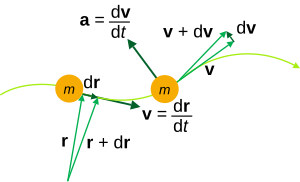
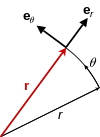

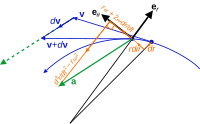
















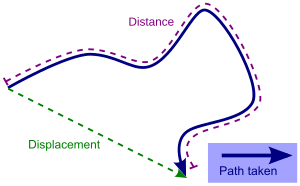
















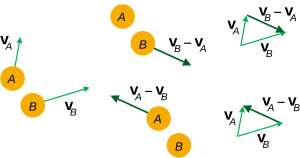










































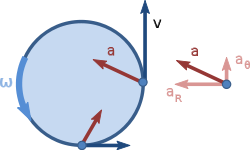













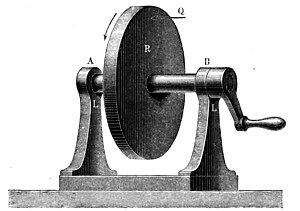








![{\displaystyle [T(\phi ,\mathbf {d} )]={\begin{bmatrix}A(\phi )&\mathbf {d} \\\mathbf {0} &1\end{bmatrix}}={\begin{bmatrix}\cos \phi &-\sin \phi &d_{x}\\\sin \phi &\cos \phi &d_{y}\\0&0&1\end{bmatrix}}.}](https://wikimedia.org/api/rest_v1/media/math/render/svg/50078656eb1b2395a2ad84383cd16868c54649b1)
![{\displaystyle \mathbf {P} =[T(\phi ,\mathbf {d} )]\mathbf {r} ={\begin{bmatrix}\cos \phi &-\sin \phi &d_{x}\\\sin \phi &\cos \phi &d_{y}\\0&0&1\end{bmatrix}}{\begin{bmatrix}x\\y\\1\end{bmatrix}}.}](https://wikimedia.org/api/rest_v1/media/math/render/svg/9654bfae7e5d0f825ec57848bd5ab493f408804f)
![{\displaystyle \mathbf {r} (t)=[T(0,\mathbf {d} (t))]\mathbf {p} =\mathbf {d} (t)+\mathbf {p} .}](https://wikimedia.org/api/rest_v1/media/math/render/svg/32f22d9b4fcc015f80b746db422f93b8d8d145dc)

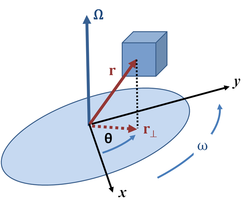
![{\displaystyle \mathbf {P} (t)=[A(t)]\mathbf {p} ,}](https://wikimedia.org/api/rest_v1/media/math/render/svg/3a4e865fc0f6be2e59e479f4b0a03f8114971382)
![{\displaystyle [A(t)]={\begin{bmatrix}\cos(\theta (t))&-\sin(\theta (t))\\\sin(\theta (t))&\cos(\theta (t))\end{bmatrix}},}](https://wikimedia.org/api/rest_v1/media/math/render/svg/53916525d50fa175a581d579e61b62d7d8a4610d)
![{\displaystyle \mathbf {v} _{P}={\dot {\mathbf {P} }}=[{\dot {A}}(t)]\mathbf {p} .}](https://wikimedia.org/api/rest_v1/media/math/render/svg/701dae17b9e581be69746145fd6133e7f07f2f16)
![{\displaystyle \mathbf {v} _{P}=[{\dot {A}}(t)][A(t)^{-1}]\mathbf {P} =[\Omega ]\mathbf {P} ,}](https://wikimedia.org/api/rest_v1/media/math/render/svg/8fac9117de99ee6837c171f5f46eede17890bcba)
![{\displaystyle [\Omega ]={\begin{bmatrix}0&-\omega \\\omega &0\end{bmatrix}},}](https://wikimedia.org/api/rest_v1/media/math/render/svg/eed637d1916abe2a271e19c744c416d1cf20e4f0)

![{\displaystyle \mathbf {A} _{P}={\ddot {P}}(t)=[{\dot {\Omega }}]\mathbf {P} +[\Omega ]{\dot {\mathbf {P} }},}](https://wikimedia.org/api/rest_v1/media/math/render/svg/62a4ca56d89ccc6d2ec6d0daffd6907b9c47ccd5)
![{\displaystyle \mathbf {A} _{P}=[{\dot {\Omega }}]\mathbf {P} +[\Omega ][\Omega ]\mathbf {P} ,}](https://wikimedia.org/api/rest_v1/media/math/render/svg/50d611f89cc9b7358cec772370a6ee8d79a792a9)
![{\displaystyle [{\dot {\Omega }}]={\begin{bmatrix}0&-\alpha \\\alpha &0\end{bmatrix}},}](https://wikimedia.org/api/rest_v1/media/math/render/svg/d6ebb7e70e2d2370e781ee86ea55cd0fb7d469d7)







![{\displaystyle \mathbf {P} (t)=[T(t)]\mathbf {p} ={\begin{bmatrix}\mathbf {P} \\1\end{bmatrix}}={\begin{bmatrix}A(t)&\mathbf {d} (t)\\0&1\end{bmatrix}}{\begin{bmatrix}\mathbf {p} \\1\end{bmatrix}}.}](https://wikimedia.org/api/rest_v1/media/math/render/svg/6e928b50529956cc7ca762cee6969f7321c5cf9d)
![{\displaystyle \mathbf {p} =[T(t)]^{-1}\mathbf {P} (t)={\begin{bmatrix}\mathbf {p} \\1\end{bmatrix}}={\begin{bmatrix}A(t)^{\text{T}}&-A(t)^{\text{T}}\mathbf {d} (t)\\0&1\end{bmatrix}}{\begin{bmatrix}\mathbf {P} (t)\\1\end{bmatrix}}.}](https://wikimedia.org/api/rest_v1/media/math/render/svg/3e1aa622ad90b69b42880d95b90afb0b27407a60)
![{\displaystyle [A(t)]^{\text{T}}[A(t)]=I.\!}](https://wikimedia.org/api/rest_v1/media/math/render/svg/e132dec7e35a3f7b5135d601bb20851ce2abe646)
![{\displaystyle \mathbf {v} _{P}=[{\dot {T}}(t)]\mathbf {p} ={\begin{bmatrix}\mathbf {v} _{P}\\0\end{bmatrix}}=\left({\frac {d}{dt}}{\begin{bmatrix}A(t)&\mathbf {d} (t)\\0&1\end{bmatrix}}\right){\begin{bmatrix}\mathbf {p} \\1\end{bmatrix}}={\begin{bmatrix}{\dot {A}}(t)&{\dot {\mathbf {d} }}(t)\\0&0\end{bmatrix}}{\begin{bmatrix}\mathbf {p} \\1\end{bmatrix}}.}](https://wikimedia.org/api/rest_v1/media/math/render/svg/4d216e15ab36a895fa2fa109fbdf77b9590d5ccb)
![{\displaystyle {\begin{aligned}\mathbf {v} _{P}&=[{\dot {T}}(t)][T(t)]^{-1}\mathbf {P} (t)\\[4pt]&={\begin{bmatrix}\mathbf {v} _{P}\\0\end{bmatrix}}={\begin{bmatrix}{\dot {A}}&{\dot {\mathbf {d} }}\\0&0\end{bmatrix}}{\begin{bmatrix}A&\mathbf {d} \\0&1\end{bmatrix}}^{-1}{\begin{bmatrix}\mathbf {P} (t)\\1\end{bmatrix}}\\[4pt]&={\begin{bmatrix}{\dot {A}}&{\dot {\mathbf {d} }}\\0&0\end{bmatrix}}A^{-1}{\begin{bmatrix}1&-\mathbf {d} \\0&A\end{bmatrix}}{\begin{bmatrix}\mathbf {P} (t)\\1\end{bmatrix}}\\[4pt]&={\begin{bmatrix}{\dot {A}}A^{-1}&-{\dot {A}}A^{-1}\mathbf {d} +{\dot {\mathbf {d} }}\\0&0\end{bmatrix}}{\begin{bmatrix}\mathbf {P} (t)\\1\end{bmatrix}}\\[4pt]&={\begin{bmatrix}{\dot {A}}A^{\text{T}}&-{\dot {A}}A^{\text{T}}\mathbf {d} +{\dot {\mathbf {d} }}\\0&0\end{bmatrix}}{\begin{bmatrix}\mathbf {P} (t)\\1\end{bmatrix}}\\[6pt]\mathbf {v} _{P}&=[S]\mathbf {P} .\end{aligned}}}](https://wikimedia.org/api/rest_v1/media/math/render/svg/6aa70149e117b2b14b1f6d473dd453dc5530c7e6)
![{\displaystyle [S]={\begin{bmatrix}\Omega &-\Omega \mathbf {d} +{\dot {\mathbf {d} }}\\0&0\end{bmatrix}}}](https://wikimedia.org/api/rest_v1/media/math/render/svg/90d988bfd6ff36b285d6294bf167b63d5f91bdef)
![{\displaystyle [\Omega ]={\dot {A}}A^{\text{T}},}](https://wikimedia.org/api/rest_v1/media/math/render/svg/21d0117f60aeca689c59abbfe4b88b1a287a1b63)
+{\dot {\mathbf {d} }}=\omega \times \mathbf {R} _{P/O}+\mathbf {v} _{O},}](https://wikimedia.org/api/rest_v1/media/math/render/svg/127655f82eb90e56b116afbcf8aa567b908e516b)


![{\displaystyle \mathbf {A} _{P}={\frac {d}{dt}}\mathbf {v} _{P}={\frac {d}{dt}}\left([S]\mathbf {P} \right)=[{\dot {S}}]\mathbf {P} +[S]{\dot {\mathbf {P} }}=[{\dot {S}}]\mathbf {P} +[S][S]\mathbf {P} .}](https://wikimedia.org/api/rest_v1/media/math/render/svg/80998957f2829ada7a5e77e2fb68a31285e843cb)
![{\displaystyle [{\dot {S}}]={\begin{bmatrix}{\dot {\Omega }}&-{\dot {\Omega }}\mathbf {d} -\Omega {\dot {\mathbf {d} }}+{\ddot {\mathbf {d} }}\\0&0\end{bmatrix}}={\begin{bmatrix}{\dot {\Omega }}&-{\dot {\Omega }}\mathbf {d} -\Omega \mathbf {v} _{O}+\mathbf {A} _{O}\\0&0\end{bmatrix}}}](https://wikimedia.org/api/rest_v1/media/math/render/svg/4a39702184d0f72216205c32ebcfa8e0e9c3b478)
![{\displaystyle [S]^{2}={\begin{bmatrix}\Omega &-\Omega \mathbf {d} +\mathbf {v} _{O}\\0&0\end{bmatrix}}^{2}={\begin{bmatrix}\Omega ^{2}&-\Omega ^{2}\mathbf {d} +\Omega \mathbf {v} _{O}\\0&0\end{bmatrix}}.}](https://wikimedia.org/api/rest_v1/media/math/render/svg/557b35e24d57f15d0c9d2998053809be7105a2f9)






